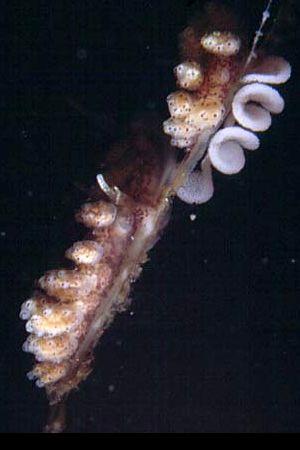
Doto dunnei
Lemche, 1976
Order: NUDIBRANCHIA
Suborder: DENDRONOTINA
Family: Dotidae
DISTRIBUTION
Known from the British Isles and northern Spain [Atlantic coast].
PHOTO
Manse reef, Ballachulish, Loch Leven, west coast of Scotland. 15 July, 2001. A pair of spawning animals on a hydroid in 12 metres of water. Photo: Jim Anderson.
This species grows to about 25 mm in length. It is distingusihed by the reddish brown or black streaks and patches on the body, and the cerata which have reddish brown or black terminal spots on the ceratal tubercles, and similarly coloured streaks on the ceratal skin between the tubercles. There are 7-8 pairs of cerata, each with seven circlets of rounded tubercles. This species feeds on the calyptoblastic hydroid Kirchenpaueria pinnata. Described by Lemche from Galway Bay, Ireland, D. dunnei is now known also from west Scotland (near Oban), from Northern Ireland and from Lundy Island in the Bristol Channel. Outside Britain it is known only from Galicia (northern Spain).
There are many species of Doto reported from the North Atlantic. Bernard Picton's website Nudibranchs of the British Isles has a comprehensive coverage of most of the species.
Reference:
• Thompson, T.E. (1988) Molluscs: Benthic Opisthobranchs (Mollusca: Gastropoda). Synopses of the British Fauna (New Series). No. 8. 2nd Edition. E.J.Brill/W. Backhuys: Leiden. 1-356.
Rudman, W.B., 2001 (December 3) Doto dunnei Lemche, 1976. [In] Sea Slug Forum. Australian Museum, Sydney. Available from http://www.seaslugforum.net/find/dotodunn
Related messages
Doto dunnei from Scotland
December 12, 2001
From: Jim Anderson

Dear Dr. Rudman,
Here is a photo of Doto dunnei from Scotland.
Manse reef at Ballachulish, Loch Leven on the west coast of Scotland. 15 July, 2001. a pair of spawning animals on a hydroid in 12 metres of water. There were many of these animals and their spawn among the hydroids between 10 and 20 metres.
Regards,
Jim A
jander4454@aol.com
Anderson, J., 2001 (Dec 12) Doto dunnei from Scotland. [Message in] Sea Slug Forum. Australian Museum, Sydney. Available from http://www.seaslugforum.net/find/5745Thanks Jim,
Bill Rudman
